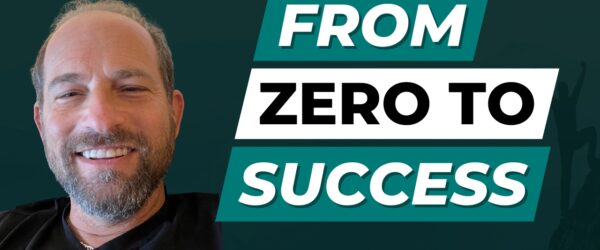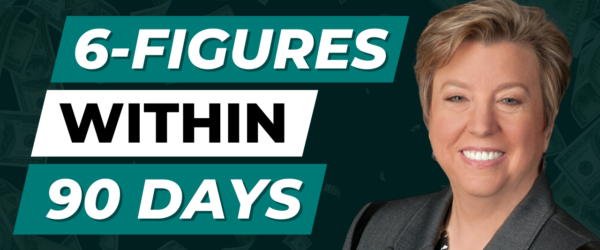On a recent Happy Hour Hangout we had the pleasure of hearing from Mark Thompson, who has discovered a powerful approach that can revolutionize the way you close deals and expand your business. Imagine gaining access to other businesses' Rolodex and tapping into a network of potential clients that align perfectly with your target audience.
In this article, we will explore Mark's insights on finding complementary businesses and building fruitful relationships with them, ultimately unlocking a 40% increase in deal closures. Prepare to discover a game-changing strategy that not only simplifies client acquisition but also enhances client retention. Whether you're in SEO, marketing, PPC, social services, or any other field, get ready to take your business to new heights with this innovative approach. Let's dive in and learn how accessing other businesses' Rolodex can transform your business growth journey!
Mark’s Background & Expertise
Mark Thompson brings a wealth of experience and expertise to the table, with a journey that spans 15 years as an online entrepreneur. After being let go from his last nine-to-five job, Mark saw it as a blessing in disguise, propelling him toward his entrepreneurial endeavors. Having previously worked for various marketing agencies, he acquired a diverse skill set in areas such as search engine optimization, pay-per-click advertising, social media, and email marketing. Mark's thirst for knowledge led him to absorb everything he could, honing his abilities in working with clients and delivering results.
Recognizing his desire to forge his own path, Mark spent five years preparing to launch his own marketing agency. When the moment finally arrived, he found himself starting from scratch without any existing clients, social proof, or case studies. Undeterred, Mark took a unique approach. Instead of going door-to-door or reaching out randomly, he embarked on a quest to tap into other businesses' Rolodex. This journey of finding his first customer was a challenging yet transformative experience that laid the foundation for his remarkable strategy.
Power Partner Approach
Realizing the challenges of traditional prospecting methods, Mark sought a different approach that would yield better results. He discovered the power of partnering with complementary businesses, particularly web design companies, web development firms, and marketing agencies. Recognizing that these businesses often lacked marketing expertise or additional services to offer after creating websites or apps, Mark saw a perfect opportunity.
He reached out to numerous businesses in his area, building relationships and positioning himself as a preferred partner or vendor. This approach proved to be a game-changer as Mark gained access to a vast Rolodex of potential leads. Leveraging the existing relationship between these businesses and their clients, Mark found it incredibly easy to sell his services. The decision-makers were already familiar with him through their previous collaboration, making the sales process feel like a slam dunk. As his network expanded, Mark even began partnering with traditional sales reps, tapping into their extensive customer base and offering current and desired services. By embracing this innovative and collaborative strategy, Mark not only overcame the initial struggles of finding clients but also paved the way for seamless and successful sales opportunities.
Building Momentum & Case Studies
To gain traction in the early stages, Mark adopted a strategic approach that involved targeting small agencies and independent contractors. He recognized that independent contractors, often found on platforms like Upwork or Craigslist, were more accessible and open to discussions. By partnering with them initially, Mark built the foundation for his business and began expanding his network. As he progressed, he shifted his focus to smaller agencies consisting of a few team members, typically including a designer, a back-end developer, and a sales-oriented owner.
To kickstart these partnerships, Mark made an enticing offer: providing his services for free. While this may seem counterintuitive, Mark's intention was to generate momentum and establish valuable case studies. By showcasing successful projects with local restaurants, insurance companies, and more, he could demonstrate the impact of his services and attract future clients. Mark acknowledges that offering free services may be a necessary step for entrepreneurs starting their own businesses or marketing agencies, emphasizing the importance of starting somewhere and building a strong foundation, even if it means initially providing some services at no cost.
Services to Offer & Scalability
When it came to the services he offered, Mark initially focused on search engine optimization (SEO) and pay-per-click (PPC) advertising. At the time, SEO was relatively straightforward, enabling Mark to achieve quick results and impress his clients. However, as the landscape shifted, with the rise of AI, video, and social media, Mark realized the importance of specializing in one area to avoid spreading himself too thin. He advises entrepreneurs to start by excelling in a single service, whether it's mobile, AI, video, social media, SEO, or content creation.
By becoming known as an expert in that specific field, it becomes easier to establish a reputation and attract clients. Mark also emphasizes the significance of focusing on services with higher profit margins, as they lead to greater financial returns. Although he eventually transitioned from a service-based business to software and digital products for increased scalability and profitability, Mark emphasizes that service-based businesses can still be scaled effectively. It's crucial to offer services that have a direct monetary impact on clients, whether through generating leads, boosting sales, saving time, or increasing efficiency. Ultimately, honing one's craft in a single service can take time but yields significant benefits in the long run.
Expansion Revenue, Add-On Services, and Leveraging AI
As technology advances, it opens up new avenues for expansion revenue and add-on services. Mark highlights the importance of building an efficient machine and systematizing processes to maximize productivity. With the emergence of AI, tasks that were once time-consuming can now be automated with ease, making businesses leaner and more streamlined. Mark shares an example of leveraging AI for voiceover services, where he created a video using AI-generated voice talent. Surprisingly, when he presented the video to others, they couldn't distinguish between the AI voiceover and a real person.
This showcases the remarkable progress of AI and its potential to transform various industries. Mark advises businesses to allocate time to explore the possibilities of AI, as it will have applications in every niche. Failure to leverage AI could result in higher costs and falling behind competitors who embrace the technology. While the rapid advancement of AI may seem intimidating, its potential to revolutionize processes and drive efficiency cannot be ignored.
Zero Time Prospecting
One of the key advantages of building partnerships is the opportunity for warm introductions to prospects. When a partner has delivered excellent work for their customer, it becomes much easier to secure a meeting. A warm introduction sets the stage for a direct path to the decision-maker, eliminating the need for time-consuming prospecting and research. Mark Thompson refers to this as "zero-time prospecting," and it revolutionized his approach to lead generation. By bypassing the typical challenges of breaking the ice and getting lost in a sea of emails, Mark achieved a remarkable 60% closure rate on his leads. The established relationship and trust he was able to leverage through partnerships allowed him to charge 50 to 75% more for his services.
Not only did this result in increased revenue, but it also led to longer client retention, with clients staying with him three times longer than before. The win-win situation was evident as the reduction in prospecting time enabled Mark to allocate a certain percentage back to his partners while maintaining higher margins on the services offered. Ultimately, building partnerships and benefiting from warm introductions proved to be a game-changer for Mark's success in closing deals and growing his business.
Be Okay with Saying No
Learning to say no is a valuable lesson that Mark Thompson experienced firsthand, as did his wife when she started her interior design business. The temptation to take on every client, regardless of fit or potential difficulties, can be strong. However, saying yes to the wrong clients often leads to unsatisfactory results and wasted time. Mark advises listeners not to be afraid of saying no. He shares that he found himself spending more time with clients who paid less and caused more trouble, while those who paid higher fees were less demanding and required minimal interaction.
Recognizing the red flags and avoiding problematic clients is crucial for maintaining efficiency and focus. By turning down ill-fitting clients, Mark discovered that they often come back, accepting the originally quoted price they had previously hesitated on. Furthermore, Mark found that stating no actually enhances credibility. It communicates that he values a good fit and is confident in his expertise. Interestingly, when clients hear no, it can lead to more business. Mark's experience emphasizes the importance of setting boundaries, knowing your worth, and being selective with clients to foster more successful and fruitful business relationships.
Raise Your Prices
Mark highlights a crucial lesson he learned from his experience with selling PayKickstart, a billing and affiliate management solution. One of his biggest mistakes was waiting too long to raise prices. Despite the product's maturation and the addition of more value, the pricing remained stagnant for three years. Mark emphasizes the importance of knowing your worth and the value you bring to the table. He advises entrepreneurs to raise their prices every six months, pushing the limits within reason. By doing so, not only did Mark attract higher-quality clients, but he also found that the more he increased prices, the better the market responded.
Mark encourages continuous tweaking and improvement in the offering, just as software companies constantly update features and plans. In a service-based business, identifying the services with the most value and adjusting rates accordingly is essential. The structure, plans, and pricing work in harmony to communicate value and generate revenue. Mark's experience demonstrates the benefits of periodically raising prices, staying competitive, and continually enhancing the value proposition for clients.
Circle Back to Old Prospects
Mark emphasizes the importance of revisiting prospects who didn't initially close the deal. He introduces the concept of a reactivation sequence, which involves sending out an email to reconnect with these prospects. The email is simple yet effective, with a response rate of approximately 40%. It starts by addressing the prospect by their first name and checking in on how things have been since the last conversation. Mark emphasizes that timing is crucial because a "no" today doesn't necessarily mean a "no" six months from now. He recommends implementing an email that gets sent every six months, ensuring the business stays top of mind for these prospects.
This strategy often leads to positive responses from prospects who may have changed their circumstances or are now in a better position to consider the services offered. Mark encourages entrepreneurs not to hesitate in reaching out to previous customers as well, even if they have canceled or undergone significant changes. By maintaining regular contact every three months, six months, or even annually, businesses can capitalize on the potential return of these customers. Mark underscores that as long as the previous experience was positive and the product and service were of high quality, many customers will be open to coming back. Additionally, he mentions that raising prices can be associated with quality and can lead to the perception of increased value. By understanding their target market and adjusting pricing accordingly, businesses can position themselves for success and offer customized support based on their pricing structure.
Outreach Strategy
Mark shares his outreach strategy for reaching potential partners. He starts by sending hyper-personalized cold emails, manually written without using any software. This approach has yielded a high response rate of around 96%. The email subject line is crafted to entice the recipient, mentioning a quick coffee near their office to keep it convenient. Mark highlights the value proposition by stating how he has helped local businesses generate leads and offers to be an extension of their business through complementary services. He emphasizes the benefits, such as adding revenue without any effort on their part. If the initial email doesn't garner a response, Mark proceeds to connect on LinkedIn and follows up with a reminder message.
Another approach is to send a personalized video to stand out from generic spam emails. If all else fails, Mark suggests utilizing a reactivation campaign, referencing the previous interaction or highlighting recent successes. He advises adapting the outreach strategy based on the size of the company and finding the appropriate person to connect with, even if it means starting from the bottom and working upward or vice versa. This comprehensive approach increases the chances of establishing partnerships and collaborations.
Implementing, Delegating & Refining
Mark emphasizes the importance of implementing efficient systems and delegating tasks to save time as an entrepreneur. He uses his wife's interior design business as an example, highlighting the challenge of letting go and outsourcing. Mark advises focusing on revenue-generating activities rather than getting caught up in operational tasks. He suggests identifying which tasks consume the most time and finding affordable freelancers through platforms like Upwork, Fiverr, or even Amazon MTurk. By outsourcing, entrepreneurs can steer the ship, manage quality control, and continuously refine their services. Mark encourages an iterative approach, emphasizing the need for constant implementation and refinement in marketing-related services.
He uses the analogy of running a football team, always looking for talented individuals, and being willing to replace team members if necessary to improve the overall performance of the business. Mark emphasizes the value of testing and assessing potential hires through short-term projects to identify motivated and dedicated individuals who can contribute to business growth. Both offline and online businesses can benefit from this approach.
Sell Your Knowledge
Mark shares his journey of transitioning from the offline world to the online space, driven by a desire for the internet lifestyle and the ability to work remotely while generating income. Recognizing the value of his knowledge and expertise, Mark decided to sell his knowledge by creating digital products such as courses and membership programs. He emphasizes that everyone possesses a unique skill or knowledge that others are willing to pay for, even if they know just 50% more about a specific topic. Mark recalls his first digital product, the Link Builder's Toolkit, and acknowledges that while it didn't perform exceptionally well initially due to a lack of effective marketing strategies, it served as a valuable learning experience in selling digital products.
Mark encourages blending offline and online approaches, recognizing that opportunities exist to offer services or products to those seeking to learn and implement strategies themselves. He recommends developing step-by-step programs and pricing them accordingly, allowing individuals to acquire knowledge and skills in their niche of interest. Mark concludes by highlighting the potential of blending offline and online aspects within one's business, emphasizing the benefits of exploring this approach.
Facebook Group Prospecting
Mark highlights the power of engaging with relevant groups on Facebook, even without a substantial following. By showcasing tangible results and success stories, individuals can attract attention and inquiries from group members. Mark suggests posting teaser content that focuses on the end results rather than a hard sell. As comments pour in expressing interest and a desire to learn more, direct messages can be used to book quick 10-minute calls. During these conversations, individuals can tailor their pitch based on the potential client's needs and preferences, offering either services or digital products.
Mark emphasizes the importance of having different tiers of offerings to cater to clients with varying budgets and requirements, from those looking to spend a few hundred dollars a month to higher-end clients willing to invest several thousand dollars. The idea of tiered pricing applies to both services and software, allowing for scalability and capturing revenue across different customer segments. Mark concludes by acknowledging Damien's successful implementation of this strategy with GoMobile, where different packages and bolt-on services are available to meet diverse customer needs.
Best Advice: Be great at one thing
Mark's best advice, although easier said than done, is to excel at one thing. As an entrepreneur, it's natural to feel pulled in multiple directions, with a mind constantly racing. However, Mark emphasizes the importance of focusing and dedicating oneself to a single endeavor. He shares his own experience with PayKickstart, a project he worked on for seven or eight years, pouring his energy into making it the best it could be. Eventually, this dedication paid off as the company was acquired and achieved sustainable recurring revenue.
Mark's realization was profound: by being exceptional at one thing, all aspects of the business fell into place, eliminating the need to spread oneself thin. This insight serves as a valuable lesson for entrepreneurs, urging them to concentrate their efforts and strive for excellence in a specific area.
Conclusion
In conclusion, Mark Thompson's insights have provided valuable strategies and lessons for revolutionizing business growth and success. By tapping into other businesses' Rolodex, entrepreneurs can access a network of potential clients that align with their target audience, leading to increased deal closures and client retention. Mark's power partner approach, building partnerships with complementary businesses, offers a game-changing strategy for client acquisition.
Additionally, focusing on one's expertise, honing a specific service, and continuously refining it can lead to greater credibility and revenue. Implementing efficient systems, delegating tasks, and blending offline and online approaches contribute to business scalability and success. Mark's best advice to excel at one thing serves as a reminder for entrepreneurs to concentrate their efforts and strive for excellence. By following these strategies, businesses can experience transformative growth and unlock their full potential.





